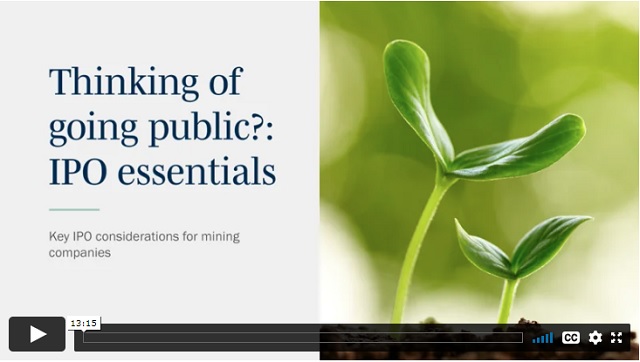- with Inhouse Counsel
- with readers working within the Banking & Credit, Insurance and Healthcare industries
With more than 40% of the world's public mining companies listed on the Toronto Stock Exchange and TSX Venture Exchange, IPOs are an important source of capital for Canadian miners. In this video, Braden Jebson and Carly Klinkhoff of both our Corporate and Mining and Metals groups dig into the top points mining leaders should consider when taking their companies public on either side of the Canada-U.S. border.
Included in this video:
- How to meet listing requirements when going public;
- Why pre-IPO technical reports often need to change in advance of an IPO;
- Whether one technical report can satisfy both Canadian and U.S. requirements; and
- How to tell the company's ESG story for two different purposes—marketing and disclosure compliance.
Click here to visit the main IPO series page.
Video Transcript
Braden Jebson (00:10): Hi everyone, and thanks for joining us today in our latest installment of the Torys IPO essentials video series. Today we'll be discussing some key considerations for mining companies in the context of considering an IPO. I'm Braden Jebson, and I'm a Senior Associate in our corporate group Torys, and my practice focuses on the mining and metals sector.
Carly Klinkhoff (00:29): My name is Carly Klinkhoff. I'm a Senior Associate in the corporate group at Torys, and I also focus on the mining and metals space.
Braden Jebson (00:36): Today we'll be building off some of the topics discussed in our prior installments, with an emphasis on the issues faced by mining companies in considering an IPO. We'll briefly look at why mining issuers should be considering an IPO in the current market. We'll then discuss the preparation and disclosure of reserves and resources, and technical reports. We'll touch on some considerations specific to mining companies in the context of dealing with regulators and exchanges. And we'll finish up with a brief discussion of ESG considerations for mining companies considering an IPO.
Carly Klinkhoff (01:11): So for 2022, we're coming off of a record-breaking year last year. It was particularly strong in life sciences, technology and the clean tech sectors. A lot of that's dropped off. In 2022, however, one area where we've seen notable activity is in the metals and mining sector. We've seen IPOs, reverse takeover transactions and many other financing transactions.Braden, perhaps you can tell us a bit more about one particular area where we've seen a lot of activity in the mining sector.
Braden Jebson (01:49): Even in a challenging market, we have seen mining companies continue to be able to tell the story of the global energy transition and their role within that. We're thinking battery metals and other clean energy techs that rely on metals and commodities. A particularly good example is the recent Ivanhoe Electric IPO, which in a challenging market was still quite successful and was one of the largest IPOs in several months.That IPO told a blended story of mineral development and exploration properties in critical metals for the global energy transition, as well as a battery storage business. It's a really good example of the synergy between the mining industry and the global energy transition and the story that can be told. Carly, do you want to talk a little bit about what issues mining issuers should be considering when they go to list on exchanges, and then talk a little bit about the reserve and resource reporting?
Carly Klinkhoff (02:42): Absolutely. So if you're a company in the mining sector that's looking to list on an exchange. You need to make sure, of course, that you meet the listing requirements. In Canada, that's typically going to be the TSX, the Toronto Stock Exchange, or the TSX Venture Exchange. For a mining company that's considering listing on the TSX. The basic listing requirements are divided into two categories: requirements for producing issuers and requirements for exploration and development stage companies.
Depending on the stage of the company and the nature of the company, you'll need to fit into one of those categories. On the TSX, you can list as an exempt issuer or a nonexempt issuer. For nonexempt issuers, there are additional requirements under the TSX Company Manual. In terms of requirements for the TSX Venture Exchange. Those requirements are quite similar, but somewhat less onerous. In terms of reporting around resources and reserves. Now, when we talk about a company in the mining sector that will be listed on a public stock exchange, the company will become a reporting issuer that's subject to a mineral disclosure regime of National Instrument 43-101. 43-101 sets out the rules for disclosure of scientific information around material properties, and reserves and resources. It also includes the requirements as Braden will talk about later for any technical reports that are filed. It's worth mentioning that 43-101 is currently open for consultation with comments due in mid-September of this year. Braden, do you want to talk further about the technical reports?
Braden Jebson (04:31): Yeah, absolutely. So technical reports are the key requirement—probably or potentially the longest lead item for companies considering a mining IPO. Technical reports are required for all material properties for an issuer and must be filed upon becoming a reporting issuer. So the assessment of what technical reports needed are a key gating item in considering an IPO. There are no black and white thresholds as to what constitutes materiality, but there is guidance in the companion policy to National Instrument 43-101.Materiality is an assessment of the issuer, but you should always discuss with counsel in that context. We would note that issuers may have already completed specific studies on their projects in the context of developing the project and privately raising funds, but it is necessary to consider whether those reports meet the requirements of National Instrument 43-101. One of the key considerations is the authors of those reports.The author of a technical report must be a qualified person, and in the context of an IPO, must be independent. In addition to assessing the authors of the report, you need to assess the content of the report to make sure that it meets the form requirement and also that a current personal inspection has been completed on the property at the time of filing.It's less of a consideration now that COVID travel restrictions have eased, but always a consideration, and particularly in case travel restrictions are again imposed, that a personal inspection has been made. It's a similar assessment to be made in respect of title opinions and title reports that we would note there are no formal statutory requirements. So it will be important for issuers to discuss what their underwriters the expectations and requirements for those title opinions, and to ensure that the necessary supporting documentation is available early in the process.
Carly Klinkhoff (06:20): We often advise clients throughout the IPO process to proactively engage with regulators. I think in particular when we're talking about the technical disclosure that Braden was referencing, you know, in the context of a confidential filing of a technical report with regulators, you want to make sure that you build in additional time to be able to engage and for regulators to be able to review that disclosure.
Braden Jebson (06:46): So I thought we'd briefly touch on some issues for issuers considering a cross-border listing in the United States. For issuers considering a cross-border listing, you'll need to comply with both mineral disclosure regimes. National Instrument 43-101 and S-K 1300 in the United States. S-K 1300 was recently introduced as part of an effort to modernize and align the US mineral disclosure regime with other international disclosure regimes, such as National Instrument 43-101 or the JORC Code in Australia.But that effort wasn't perfect. So there are still some differences that issuers should consider in the necessary preparation of the technical reports in Canada and the technical report summary in the United States. Now with good planning and the appropriate technical consultants, mining issuers should be able to have a single report that meets the requirements of both jurisdictions. We would note for royalty issuers that there is no royalty exemption regarding technical reports in the United States.So mining issuers that have royalties should consider the availability of technical report summaries from the operators of those projects and should know if they do not have a technical report summary, the royalty company will need to provide a technical report summary meeting the requirements of S-K 1300. This can be a challenge given the access rights that some royalty companies have, so it needs to be considered early in the process.Also thought it'd be helpful to briefly touch on some diligence considerations that may be a bit unique in the mining context, and particularly for cross-border issuers. One is ensuring that your qualified persons and technical consultants are prepared for the diligence process. They will be highly involved, will be taking part on the diligence call, and may also engage with technical consultants that have been gauged by the underwriters to review the technical work.The final consideration is the necessity of site visits and ensuring that you have the appropriate access rights. This isn't often an issue for operators, but for companies that have joint venture interests or royalty interest. You'll need to early in the process ensure that you have the appropriate access for site visits. One other consideration unique to the US is that you may actually see legal counsel also be included on the site visit, which we don't typically see in Canadian IPOs.
Carly Klinkhoff (09:07): We wanted to touch now on ESG matters. ESG, environmental social governance, is a hot topic in capital markets generally, and in particular in the mining industry, as it has been for some time. Braden, do you want to talk a bit more about that?
Braden Jebson (09:24): Yeah absolutely. As a practical matter, mining issuers have always been focused on ESG concerns in the context of operating their business and maintaining their social license to operate. A key challenge for mining issuers now is telling that ESG story in a way that accurately and meaningfully describes the ESG efforts as part of their marketing effort, but also in a way that is consistent with international standards and best practices for disclosure and regulatory requirements.
Carly Klinkhoff (09:49): And I think in terms of the IPO context, what we've seen is issuers spending a lot of time thinking about what investor expectations are and what those requirements are to ensure compliance.
Braden Jebson (10:03): Yeah absolutely. So disclosure regarding ESG and climate related matters is a key regulatory focus in Canada and globally. There are existing requirements under securities law relating to ESG and climate related matters, but those aren't typically focused on climate-related disclosure. So there have been efforts to enhance and standardize climate-related disclosure. This was a key focus in the Capital Markets Modernization Taskforce report that came out in early 2021.
And later in 2021, the CSA proposed National Instrument 51-107 to help standardize climate-related disclosure across issuers. Carly, do want to talk a little bit about the proposed National Instrument 51-107?
Carly Klinkhoff (10:50): Absolutely. So 51-107 would require issuers to make annual disclosure related to various ESG matters. We're talking about governance, corporate strategy, risk management practices, data and metrics in respect of climate change risks, and of course, greenhouse gas emissions. The comment period for this proposed instrument would close on February 16th, and assuming an effective date of December 31st of this year, would apply to non-venture issuers in 2024 in respect of fiscal 2023 and for venture issuers in 2026 in respect of fiscal 2025.
Braden Jebson (11:36): We'd also note that the SEC recently introduced a rule proposal around climate-related disclosure. It's somewhat more stringent than the CSA's principle-based approach and has additional disclosure requirements, particularly around greenhouse gas emissions. The comment period for that closed in June and the timing for the introduction of that, if adopted, is uncertain but will likely depend on filer status and the particular disclosure requirements.
Carly Klinkhoff (12:03): So lastly, in relation to ESG matters and IPOs in the mining sector, we thought it was worth mentioning that it's becoming increasingly important for issuers to consider bringing on third-party experts to provide ESG reports in terms of their practices. And so what that means in an IPO context is there may be additional time that's required to bring on those third parties to produce those reports and have those incorporated into your IPO disclosure. We note as well that when you're doing an IPO, it's worth considering that the disclosure that you make related to ESG matters in the IPO documentation will be relevant for your continuous disclosure going forward once you become a public company.
Braden Jebson (12:56): Well thank you for joining us today for our discussion on issues facing mining companies in considering an IPO. We hope this was helpful. And to the extent you have any questions, please feel free to reach out. Thank you.
Carly Klinkhoff (13:09): Thank you.
The content of this article is intended to provide a general guide to the subject matter. Specialist advice should be sought about your specific circumstances.



